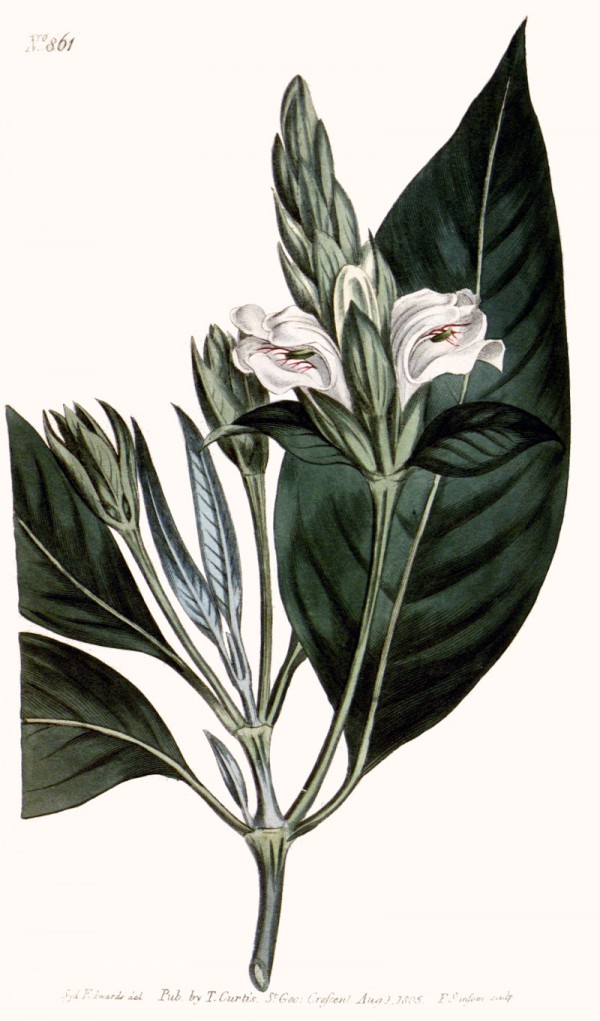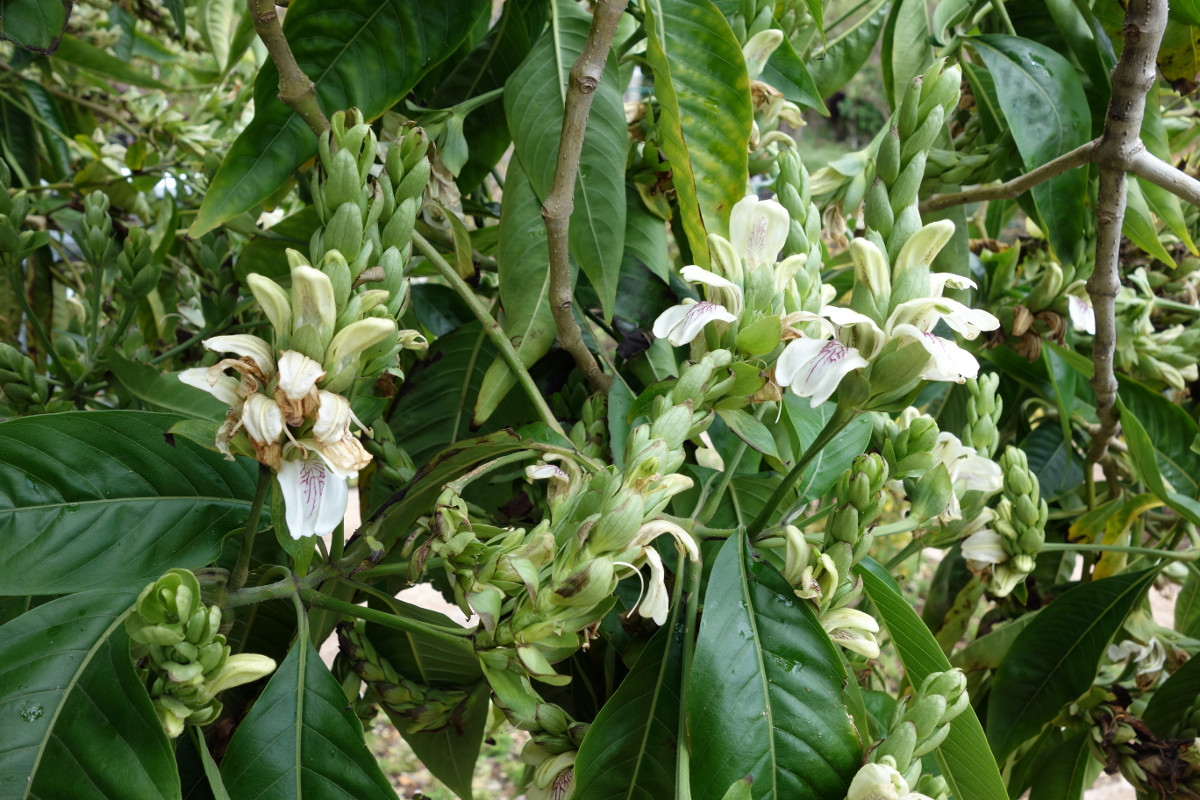Benutzer-Werkzeuge
Justicia adhatoda L. - Acanthaceae - syn. Adhatoda vasica (L.) Nees; Malbar nut, adatoda, vasaka, arusha, Indisches Lungenkraut, Malabarnuss
Evergreen dense shrub of northern India, naturalized in India, Sri Lanka, Southeast Asia, up to 2.5m high, with unpleasant smell; stem bark yellowish; leaves simple, petioled, lanceolate to elliptic, entire; white flowers in axillary spikes; spikes with long peduncles; fruit a 4-seeded capsule, 2-2.5cm long, seeds 5-7mm in diameter.
„This shrub has a number of traditional medicinal uses in Siddha Medicine, Ayurvedic and Unani systems of medicine.“ https://en.wikipedia.org/wiki/Justicia_adhatoda
The leaves contain the quinazoline alkaloids deoxyvasicine, vasicine (0.96%) and vasicinone (0.03%). Vasicine undergoes auto-oxidation to vasicinone, but the rate is very low.
„Vasicine has appreciable bronchodilatory effect and marked respiratory stimulant activities, whereas vasicinone shows relaxation of the tracheal muscle in vitro and bronchoconstriction in vivo. A detailed preclinical study revealed that vasicinone has a synergetic effect on vasicine in bronchodilation, as well as in increasing ciliary movements. It was also observed that the cardiac depressant effect manifested by vasicine was normalized by vasicinone. Vasicine and vasicinone mixed in 1 : 1 ratio has shown higher broncho-dilatory activity and antagonism against histamine induced bronchoconstriction as vasicine alone…“
[Quantitative determination of vasicine and vasicinone in Adhatoda vasica
by high performance capillary electrophoresis. B. Avula, S. Begum, S. Ahmed, M. I. Choudhary, I.A.Khan, Pharmazie 63: 20-22 (2008)]
„… even at the highest clinically used doses ambroxol does not have significant direct effects on the CNS. At clinically relevant plasma concentrations ambroxol either does not penetrate blood-brain barrier, or its brain levels are too low to cause relevant effects.
Ambroxol has been used in the therapy of airway diseases since late 1970s. Its history can be traced, however, to ayurvedic medicine in ancient India. The plant Adhatoda vasica has been used in India for similar indications for centuries. In Germany this plant is still called ‘Indisches Lungenkraut’ (Indian lung weed). The likely active substance in the plant is the alkaloid, vasicine. A chemically related drug, bromhexine, was introduced in 1965 to treat mild respiratory disorders. Ambroxol, the active metabolite of bromhexine, has been found to be responsible for the therapeutic effect; and found to be superior to bromhexine in its pharmacokinetics, efficacy, and side effect profile.“
[Ambroxol: a CNS drug?., Weiser, T., CNS neuroscience & therapeutics, 14(1), 2008, 17-24]
„Adhatoda vasica has been used in many ayurvedic formulations… Remarkable wound healing activity was observed with the ointment formulation of the methanol extract at 1% concentration.“
[Investigations on the phytochemical activities and wound healing properties of Adhatoda vasica leave in Swiss albino mice. Subhashini S., Kantha D. Arunachalam, African Journal of Plant Science Vol.5 (2), 2011, 133-145]
„Adhatoda vasica Nees (Acanthaceace) is a well known medicinal plant from which certain alkaloids, phenolics,
flavonoids, sterols and their glycoside derivatives have been isolated. Its diverse medicinal activities include cardiovascular protection, abortifacient, antitubercular, antimutagenic, antiulcer, antiasthmatic activities, hepatoprotective, antibacterial and antitussive activities. It is commonly used in indigenous and traditional folk medicine system in South-East-Asia… It is used as an herbal remedy for treating cold, cough,
whooping cough and chronic bronchitis and asthma, as sedative expectorant, antispasmodic and anthelmintic. It is an official drug and is mentioned in the Pharmacopoeia of India. The leaves, roots, flowers and bark of Adhatoda are all used for medicinal purposes. It is well known for preparation of medicine for bronchitis, asthma and other pulmonary infections.“
[Adhatoda vasica Nees: Phytochemical and Pharmacological Profile. Thokchom P Singh, Okram M Singh, Huidrom B Singh, The Natural Products Journal 01/2011; 1(29), 29-39]
http://onlinelibrary.wiley.com/doi/10.1111/j.1527-3458.2007.00032.x/full

Curtis’s Botanical Magazine, vol.22 t.861 (1805) [S.T.Edwards]
http://plantgenera.org/species.php?id_species=571752

Jusiticia adhatoda, Funchal Botanic Gardens, Andreas Kraska (2018) CC BY-SA 3.0
